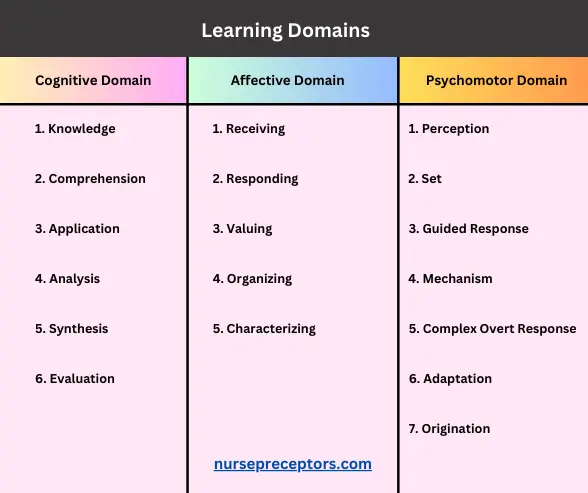Nurses play an essential role in patient education, helping individuals understand their health conditions, treatments, and how to manage their overall well-being. Recognizing the educational requirements of patients is an essential aspect of the learning process. You can learn A Comprehensive Guide for Nurses in the USA and UK from the most demanded website Nurse Preceptors.
Tailoring education to meet the specific needs of each patient enables nurses to improve patient engagement, increase adherence to treatment plans, and ultimately achieve better health outcomes.
This article explores various strategies nurses can use to identify the learning needs of patients at the clinical site, including focusing on the three main learning domains: cognitive, affective, and psychomotor. Nurses should use a constructive approach and follow these steps to identify the learning needs of patients.
Understanding the Basics: Elements-Mixtures-Compounds- Generic BSN
1. Creating a Supportive Environment
a). Patient-Centered Approach
Adopting a patient-centered approach to education involves actively involving the patient in their care and decision-making process. Nurses should encourage patients to express their preferences, values, and goals to ensure that education is aligned with their needs and expectations.
b). Encouragement and Empowerment
Supporting patients with positive reinforcement and encouragement is crucial in empowering them to take charge of their health. Nurses should acknowledge the patient’s efforts and progress, fostering a sense of confidence and motivation.
Normal Vital Signs Decoded: What Your Body’s Signals Say About Your Well-being?
2. Patient Assessment
Assessment is the initial step in the identification of learning needs. Nurses can use their senses such as sight, smell, and hearing to explore the patient’s current condition. Furthermore, reviewing medical history and interviewing patients with open-ended questions can help nurses establish baseline data for further interventions.

a). Medical History Review
The comprehension of a patient’s medical history serves as the cornerstone of delivering impactful patient education. Nurses should review medical records to gain insights into the patient’s health conditions, previous treatments, and any educational interventions they have received. This review provides a baseline for identifying gaps in knowledge and areas where the patient may need additional information.
b). Initial Patient Interview
A thorough interview with the patient in a calm and comfortable environment can reveal valuable information about their health condition, daily routine, and current knowledge.
Nurses should ask open-ended questions about the patient’s understanding of their diagnosis, treatment plan, and any concerns they may have. This conversation helps identify specific areas where the patient needs more education.
3. Observation
The patient’s response is crucial to understanding whether the information provided is completely understood by the patient or not. Nurses should continuously observe patient responses and use their knowledge to identify learning needs. The patient’s behavioral cues and physical signs offer valuable insights into the patient’s level of understanding.
a). Behavioral Cues
Observing a patient’s behavior and interactions can provide clues about their understanding and comfort level with their health condition. Signs of confusion, anxiety, or misinformation can indicate a need for additional education.
For example, a patient who seems hesitant or unsure when discussing their medication regimen may require more detailed instructions.
b). Physical Signs
Physical signs can also reveal learning needs. If a patient is using medical devices improperly or not adhering to treatment plans, it may indicate that they do not fully understand the instructions. Nurses should observe these signs and address any misunderstandings immediately.
4. Communication
Effective communication is a two-way process that explores the patient’s learning needs and needs for further education. It involves attentively addressing the patient’s concerns, employing open-ended questions, and motivating patients to rephrase their thoughts in their own words.
a). Open-Ended Questions
To facilitate patient engagement, it is beneficial to ask open-ended questions that prompt them to share their thoughts and concerns about their health. Nurses can gain valuable insights into a patient’s understanding of their current condition by asking questions such as, “Can you share with me what you know about your current condition?” and “What are your biggest concerns about your treatment?” Identifying these questions is crucial for pinpointing areas where patients may require additional information and support.
b). Active Listening
Practicing active listening entails carefully attending to the patient’s responses, tone of voice, and body language to fully understand their perspective. By fully engaging with the patient, nurses can better understand their level of comprehension and identify any areas of confusion or concern.
c). Teach-Back Method
Using the teach-back method is a constructive approach to confirming that patients have grasped the information provided. After explaining a concept, nurses should ask the patient to repeat the information in their own words. This method helps identify any misunderstandings and reinforces learning.
5. Educational Assessments
Nurses can assess and provide health education by utilizing multiple tools.
a). Health Literacy Screening
It’s important to remember the use of health literacy screening tools, such as the Rapid Estimate of Adult Literacy in Medicine (REALM) and the Test of Functional Health Literacy in Adults (TOFHLA) (50 items for reading comprehension and 17 items for numerical ability), can assess a patient’s ability to understand health information.
These tools help assess a patient’s understanding of health-related information and can be valuable in providing better care. These tools also help nurses tailor their education strategies to the patient’s literacy level.

b). Learning Style Assessment
Determining a patient’s preferred learning style—whether visual, auditory, or kinesthetic—can enhance the effectiveness of education. Nurses can ask patients about their preferences and observe how they respond to different types of information to identify the best teaching methods.
6. Patient’s Self-Assessment
a). Surveys and Questionnaires
Providing patients with surveys or questionnaires about their understanding of their condition and treatment can reveal learning needs. These tools allow patients to self-report their knowledge and identify areas where they need more information.
b). Self-Reporting Tools
Encouraging patients to use self-reporting tools or apps to track their symptoms, treatment adherence, and any difficulties they encounter can provide valuable insights. Nurses can use this information to address specific learning needs and adjust educational strategies accordingly.
7. Family and Caregiver Input
a). Family Interviews
Family members or caregivers often have additional insights into the patient’s learning needs and daily challenges. Nurses should involve family members in the educational process, asking for their observations and input to gain a more comprehensive understanding of the patient’s situation.
b). Family Education
Including family members in educational sessions ensures they can support the patient’s learning and adherence to treatment plans. Educated family members can reinforce key concepts and assist with managing the patient’s condition at home.

8. Cultural and Social Considerations
a). Cultural Competence
Being aware of cultural, religious, and social factors that influence a patient’s learning needs is essential. Nurses should adapt their educational strategies to be culturally sensitive and respectful of the patient’s background and beliefs.
b). Social Determinants of Health
Considering the patient’s socioeconomic status, access to resources, and support systems can help nurses identify potential barriers to learning. Addressing these social determinants of health can improve the effectiveness of patient education.
9. Using Technology for Education
a). Digital Resources
Leveraging digital resources, such as educational websites, apps, and online support groups, can provide patients with additional information and support. Nurses can recommend reliable online resources that align with the patient’s learning needs.
b). Telehealth
Telehealth services offer a convenient way for patients to receive education and support from the comfort of their homes. Nurses can use telehealth to conduct follow-up appointments, provide additional education, and address any questions or concerns the patient may have.
c). Detailed Documentation
Recording all observations, assessments, and educational interventions in the patient’s medical record ensures continuity of care. Detailed documentation helps other healthcare providers understand the patient’s learning needs and continue the educational process.
d). Continuous Monitoring
Regular follow-up with the patient allows nurses to reassess learning needs and adjust educational strategies as necessary. Continuous monitoring ensures that the patient receives ongoing support and education tailored to their evolving needs.
Role of Learning Domains in Patient Education
To ensure comprehensive patient education, it is important to address all three learning domains: cognitive, affective, and psychomotor. Each domain encompasses specific types of learning and skill development that are crucial for patients to understand and manage their health effectively.

1. Cognitive Domain
The cognitive domain encompasses the acquisition of knowledge and the cultivation of intellectual abilities. This involves the memorization and understanding of specific facts, procedural processes, and principles that contribute to the enhancement of intellectual skills and abilities.
This domain is essential for helping patients understand their health conditions, treatment options, and the rationale behind various medical recommendations. Within the cognitive domain, there are six intellectual skills:
2. Affective Domain
The affective domain involves feelings, values, appreciation, enthusiasm, motivations, and attitudes. This domain is crucial for addressing the emotional and psychological aspects of patient care, which can significantly impact a patient’s willingness to learn and adhere to treatment plans. The affective domain includes five major learning categories:
3. Psychomotor Domain
In the psychomotor domain, individuals engage in physical movements, coordination, and the utilization of motor skills. This domain is particularly important for patients who need to perform specific physical tasks as part of their treatment or self-care routine. The psychomotor domain includes several major categories of motor skills:
What are the Common Barriers to Patient Learning
Identifying and addressing common barriers to patient learning is essential for effective education. These barriers can impede the patient’s ability to understand and apply health information, potentially affecting their overall health outcomes.
a). Cognitive Barriers
Patients may face cognitive barriers such as difficulty understanding complex medical terminology, limited health literacy, or cognitive impairments like dementia. Nurses can address these barriers by simplifying information, using plain language, and employing visual aids or demonstrations to enhance comprehension.
b). Emotional Barriers
Emotional barriers, including fear, anxiety, or denial, can hinder a patient’s ability to learn and engage with their care. For instance, a patient who is anxious about a diagnosis may struggle to absorb information about their treatment. Nurses should provide emotional support, validate the patient’s feelings, and create a calming environment to help overcome these barriers.
c). Physical Barriers
Physical barriers include impairments that affect a patient’s ability to participate in learning activities, such as visual or hearing impairments, limited mobility, or fatigue. Nurses should accommodate these needs by providing accessible materials, using assistive devices, and ensuring that educational sessions are conducted in a comfortable setting.
d). Environmental Barriers
Environmental barriers involve factors such as inadequate space, noise, or distractions in the clinical setting. A noisy or cluttered environment can make it difficult for patients to focus on learning. Nurses should strive to create a quiet and organized space for education, minimizing interruptions and distractions.
e). Socioeconomic Barriers
Socioeconomic factors such as lack of access to resources, financial constraints, or inadequate support systems can impact a patient’s ability to learn and adhere to treatment. Nurses should be aware of these factors and provide resources or referrals to community services, financial assistance programs, or support groups as needed.
f). Cultural Barriers
Cultural barriers may include language differences, cultural beliefs, or practices that affect a patient’s understanding and acceptance of medical information. Nurses should use culturally sensitive approaches, including employing interpreters or multilingual materials and being respectful of the patient’s cultural practices and beliefs.
Conclusion
Identifying the learning needs of patients is a critical component of effective nursing practice. By employing a variety of assessment and communication strategies, nurses can tailor education to each patient’s unique needs, leading to better health outcomes and improved patient satisfaction.
Through thorough assessment, observation, communication, and continuous follow-up, nurses can ensure that patients are well-informed and empowered to manage their health effectively. Embracing technology, creating a supportive environment, and collaborating with an interdisciplinary team further enhance the patient education process.
As healthcare continues to evolve, the role of nurses in patient education remains pivotal in fostering a healthier and more informed patient population.
References
- Kluwer, W. (2017, August 23). 5 strategies for providing effective patient education. Wolters Kluwer. https://www.wolterskluwer.com/en/expert-insights/5-strategies-for-providing-effective-patient-education
- Aker, J. L., Davis, T. C., Leonard-Segal, A., Christman, L., Travis, S., Beck, M., & Newton, A. (2022). Evaluating Health Literacy in Virtual Environments: Validation of the REALM and REALM-Teen for Virtual Use. Journal of General Internal Medicine, 37(11), 2834–2839. https://doi.org/10.1007/s11606-022-07474-9
- Health Literacy in Clinical Practice. (n.d.). Medscape. https://www.medscape.org/viewarticle/566053_5
- CDC. (n.d.). Domains of Learning Audio Descriptive Text Title: Professional Development 201: From Basic to Dynamic. Adult Learning Theories; Domains of Learning. Video Summary. https://www.cdc.gov/healthyschools/professional_development/videos/pd201/04-domains_of_learning.pdf
- Indeed Editorial team. (2021). A Definitive Guide to Bloom’s Domains of Learning. Indeed Career Guide. https://www.indeed.com/career-advice/career-development/domains-of-learning